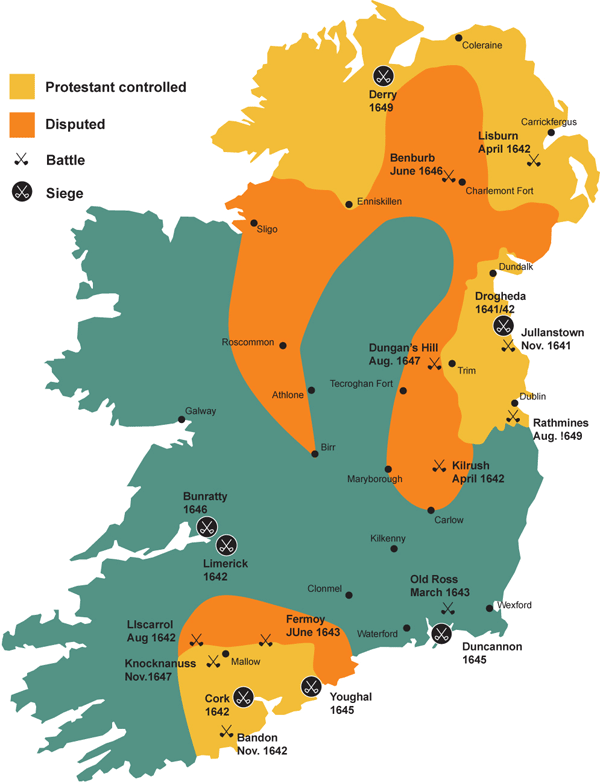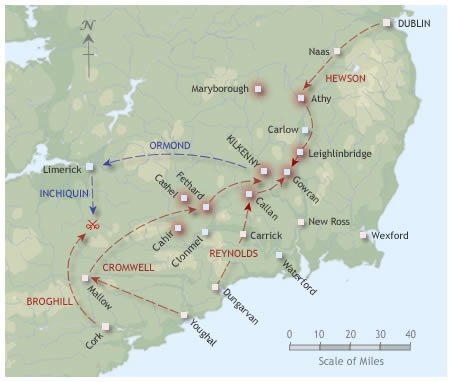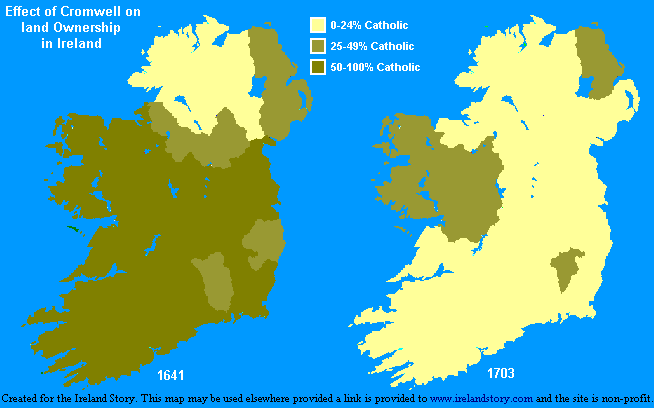
| ICE Case Studies
|
|
I.
Case Background |

In 1649, Oliver Cromwell led an invasion to re-conquer lands in Ireland of behalf of British Parliamentarians. The Irish had revolted from British rule in 1641 and had sided with British royalty in the fight. This led to conflcit that lasted over several decades. The Irish had been conquered by the Britain in the 12th century. In this long struggle they did not prevail. The aftermath of the conflict had repercussions for many years. War-related famines, directly and indirectly, killed thousands. Many were forced off their lands and others were invited in as migrants that changed the demographic make-up of the island's population.
In 1169, Norman mercenaries from England landed in Ireland to assist the ousted King of Leinster regain his lost crown. The expedition had the backing of King Henry II of England and was also supported by Pope Adrian IV. Further landings and invasions of Irish kingdoms led to the eventual subjugation of the entire country. This pattern of course was a repeat of the way that the Normans arrived in England in the first place in 1066. They were mercenaries who refused to leave.
In the early 1600s, events combined to allow a glimmer of hope fo Irish independence. Irish nationalists, coupled with Catholic Royals from Scotland, allowed the return of Irish rule in 1641. The Parliamentarians, who were Protestant and largely at odds with the Royalist Catholic government, united against them. During the uprisings, Irish in Ulster massacred Protestants and mounted a country-wide rebellion. This situation persisted until King Charles was executed in 1649 and the Parliament took over the government.

Source: Trinity College, Dublin
Crowell's campaigns lasted for nearly a decade, but in that time won back Ireland and was brutal in doing so. Lands were cleared for Protestant settlers (as well as some Catholics ones, from Scotland). One of the first Irish towns attacked was Cromwell's attack on Drogheda, County Louth in September 1649. When the town refused to surrender the English bombarded the city with artillery and then massacred everyone there: man, woman, and child. This was under Cromwell's orders.

Source: https://arranqhenderson.files.wordpress.com/2012/12/ireland_1649_1650.jpeg?w=900
The aftermath of Crowell's victory was harsh. Irish were forced off their lands in Ulster and moved to the west. The western lands were less hospitable areas for farming and agriculture. Regions in the west had very poor soil in comparison, This was a place of hardship for the migrants.
At the time, few crops were found suitable for the rocky soils of the west. This changed with the introduction of the potato. The only suitable crop to grow were potatoes, and soon the population became highly dependent on the potato for their subsistence. The reliance became extreme and ended badly a couple of hundred years later with the potato famine.
Along with the forced migration and new lands with less soli quality, the Irish population was quickly expanding. Family plots of land over 250 years shrank as pieces were doled out in ever smaller proportions to the many descendents. Property amps show slivers of land that extend from a high pont of high down to a low point, so each son had roughly similar plots.
Cromwell's government invited in English to re-locate, as well as welcome Scot's who were being thrown off their highlands areas. Rather, our Stewart’s were probably forced migrants. Scots migrating to America came in several waves, especially during the Highland Clearances that began about 1725 and continued for a century. The Highland Clearance was a rather rapid and often brutal switch from farming to sheep and wool economy. Many people were summarily thrown off their rented land, as was the case later in Ireland. Some came directly to America, but many fled to Ulster, Northern Ireland. The Irish were the only ones to welcome their Scottish cousins. They would later come to America after the Revolution and constitute the heritage of most modern Scottish-Americans.


The Parliamentarian campaign largely stayed on the eastern side of Ireland adjoining the Irish Sea. This land was closer to England, had more fertile sole, and contained good harbors. After the conflict came to a close, the British focused on evicting Catholics from these conquered lands and moving them to the west.

Cromwell's Parliamentarian forces brought the Irish Rebellion to an end in 1652 that began in 1641 (hence, the 11 years War). This phase of the war was by far the most costly in terms of civilian loss of life. Civilans were the greatest casualties through the combination of war, famine, and disease and plague. In the 1665-66 Down Survey, William Petty estimated that over 618,000 people (about 40% of the country's population), including over 400,000 were Catholics, 167,000 killed directly by war or famine. Modern estimates put the toll at closer to 20% of the population. No break-outs exist between those dead by war versus famine.

The war both directly and indirectly resulted in famine. An outbreak of bubonic plague soon followed. The Parliamentarian campaign was especially brutal in some parts, where deaths rates ranged from 15 to 83 percent. The Parliamentarians also deported around 50,000 indentured laborers. Most went to the America's, especially the Caribbean.
The Parliamentarians re-conquered Ireland. They remained in control for another 250 years. Most of the island, save for northern Ireland, was granted independence in the early 20th century.

Biafra Famine
South Sudan Civil War and Famine
30 Year's War and Famine
Cromwell's Famine
Vietnam Famine of 1945
Bengal Famine of 1943
North Korea Famine
Burkina Food Riots
Ukraine Famines
Go to Ice Search Engine and Scenario Builder
Philip McKeiver, 2007, A New History of Cromwell's Irish Campaign, ISBN 978-0-9554663-0-4
Tom Reilly, 1999, Cromwell: An Honourable Enemy, ISBN 0-86322-250-1
Famines by Joe Hasell and Max Roser, "Our World in Data", Source: https://ourworldindata.org/famines/
"The Cromwellian Conquest", University of Trinity, Dublin. Source: http://downsurvey.tcd.ie/history.html
